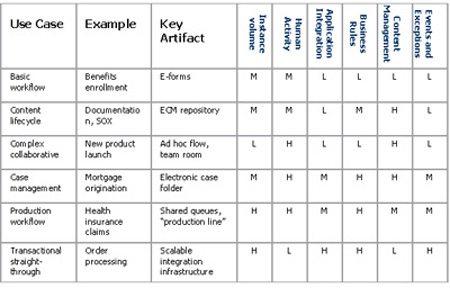I’ve just finished up four new reports in my 2006 BPMS Report series: Lombardi TeamWorks, BEA AquaLogic BPM, EMC Documentum Process Suite, and Cordys Composite Application Framework.
The BEA report replaces Fuego; the others are new, bringing the total to ten, plus an overview report that explains the common evaluation framework and report format. (The others are IBM WebSphere BPM Suite, Savvion BusinessManager, Pegasystems SmartBPM, Global 360 Enterprise, Adobe LiveCycle Workflow, and Vitria BusinessWare.) Collectively, these reports represent the leading offerings in the marketplace.
Like the others in the series, the new reports are free to download from the BPM Institute website. Each report is around 30 pages in length, loaded with diagrams and screenshots. Based on product documentation and deep-dive briefings and demos, each report walks through product functionality end to end, including modeling, process design, human workflow, application integration, business rules, content and collaboration, events and exceptions, product architecture, and solution frameworks.
It’s more than a functionality checklist, since, let’s face it, all products today can tick off all the checkmarks. But a capability that is richly elaborated in one product might just exist at a bare minimum in another. At the end, each product is evaluated for its suitability in six process types or use cases: basic workflow, content lifecycle processes, complex collaboration, case management, production workflow, and transactional/straight-through processing.
Each use case weights particular features and characteristics of the BPMS differently, as shown by the following chart:

The summary use case suitability scores are shown in the table below.

These scores don’t tell the whole story, since they don’t capture the unique capabilities and innovations that go beyond basic use case requirements. Such features might be just the thing you need in your own organization! To find out about those, and get a feel for the product, you just have to read the reports.
The notable qualities and focus of each product stand out. For example, in the new reports:
- Lombardi and Cordys show how the full power of BPMN, including intermediate events for exception handling, can be used for executable design: one based on service orchestration and the other not.
- EMC illustrates the unique capabilities of content- and collaboration-aware BPM, and provides rich support for production workflow.
- BEA demonstrates the extreme flexibility of user-defined scripted methods to cover a wide range of process types.
- Lombardi makes the promise of rapid iterative development real, with the ability to instantly play back process activities at any stage of modeling or design.
- Cordys shows what it means to layer a BPMS on top of an Enterprise Service Bus. For all their talk about SOA, most other BPMS vendors don’t do that.
While checklist-oriented marketing makes all products sound the same, the BPMS landscape is actually rich and diverse. Somewhere among these ten, one or two products will stand out as tailor-made to manage your organization’s business processes.

















